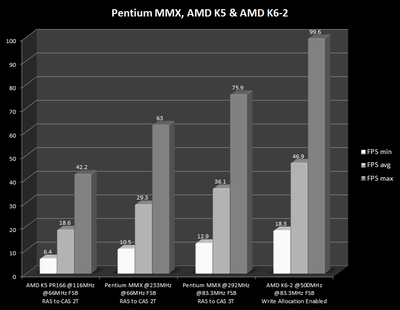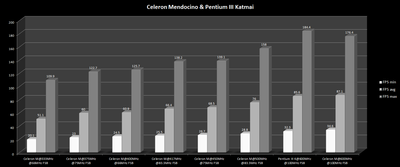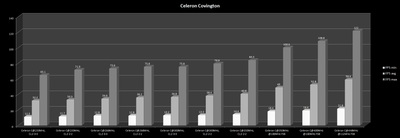First post, by SSTV2
- Rank
- Oldbie
I have long wanted to know how a heavily tweaked Pentium MMX system, from the year of 1997, would compare to Pentium II systems of the time. I recently had the opportunity to build one such Pentium MMX PC, tweak and test it 😀
Specs of the Pentium MMX system:
MB - ASUS VX97 w/buck converter, i430VX, 512KB L2;
CPU - Pentium MMX 233@292MHz / AMD K6-2 500MHz @83.3MHz FSB;
RAM - 64MB EDO;
*RAM TIMINGS: DRAM Read/Write Burst Timing x222, RAS to CAS 3T, RAS Precharge 3T;
Video - EvilKing Voodoo 3 PCI @167MHz;
Sound - SB AWE64 Gold;
BIOS - Modernized Award BIOS.
Specs of the PII system:
MB - ACER V66XA, i440BX;
CPU - Pentium II Klamath 266MHz / Pentium III Katmai 600MHz;
RAM - 256MB SDRAM;
*RAM TIMINGS @ 100MHz FSB: CAS 3T, RAS to CAS 2T, RAS Precharge 2T;
*RAM TIMINGS @ 66MHz FSB: CAS 2T, RAS to CAS 2T, RAS Precharge 2T;
Video - Voodoo 3 2000 PCI @167MHz;
Sound - Integrated Crystal CS4235;
BIOS - ACER V3.2 /w Katmai CPU uCode.
I decided to do the comparison by benchmarking only Unreal, because the performance of this game heavily depends on the CPU and the bandwidth of the system bus. The given frame rate average and min/max will allow us to directly compare CPUs of different generations and manufacturers.
Testing conditions and environment on both systems:
Win98SE, sound drivers disabled, video driver V1.07.00, USB - Enabled, Unreal ver. 226, GameRenderDevice - 3dfx Glide, default Glide Rendering settings, 640x480 resolution, texture detail - High, monsters disabled at intro Castle Flyby for frame rate consistency, results are collected after 2nd cycle and rounded to its nearest tenth.
*** PII system results:PII KLAMATH @133MHzavg 23.6min 8.6max 51.4---PII KLAMATH @166 MHzavg 29.2min 10.9max 64.9---PII KLAMATH @200MHzavg 34.7min 12.9max 76.5---PII KLAMATH @233MHzavg 39.5min 13.3max 85.3---PII KLAMATH @266MHzavg 44.2min 16.2max 95.2---PII KLAMATH @300 MHz, @66MHZ FSB, CL2-3-3avg 47.6min 18.1max 102.4---PII KLAMATH @300 MHz, @66MHZ FSBavg 48.4min 18.3max 104.9---PII KLAMATH @300MHz, @75MHZ FSBavg 49.8min 18.2max 105.5---PII KLAMATH @333MHz, @83.3MHZ FSBavg 55.5min 20.8max 116.6---PII DESCHUTES @350 MHzavg 60.4
min 22.9max 124.8---PII KLAMATH @263MHz, @75MHZ FSBavg 44.3min 16.7max 93.9---PII KLAMATH @292MHz, @83.3MHZ FSBavg 48.9min 18.2max 105.1---Celeron COVINGTON @233 MHz, CL2-3-3avg 32.2min 11.3max 65.1---Celeron COVINGTON @233 MHzavg 33.3min 11.7max 71.9---Celeron COVINGTON @266 MHz, CL2-3-3avg 34.6min 12.8max 73.6---Celeron COVINGTON @266 MHzavg 36.2min 12.8max 75.8---Celeron COVINGTON @300 MHz, @66MHZ FSB, CL2-3-3avg 36.8min 13.2max 75.8---Celeron COVINGTON @300 MHz, @66MHZ FSBavg 38.4min 13.3max 79.9---Celeron COVINGTON @333 MHzavg 40.8min 14.4max 84.3---Celeron COVINGTON @350 MHz, @100MHZ FSBavg 49.0min 18.4max 100.6---Celeron COVINGTON @400 MHz, @100MHZ FSBavg 52.8min 19.4max 108.8---Celeron COVINGTON @448 MHz, @112MHZ FSB, CL3-2-2avg 59.4min 21.8max 122.0---Celeron MENDOCINO @333 MHzavg 54.1min 20.1max 109.9---Celeron MENDOCINO @375MHz, @75MHZ FSBavg 60.0min 23.0max 122.7---Celeron MENDOCINO @417MHz, @83.3MHZ FSBavg 66.4min 25.5max 138.2---Celeron MENDOCINO @400MHz, @66MHz FSBavg 60.9min 24.5max 125.7---Celeron MENDOCINO 450MHz, @75MHz FSBavg 68.5min 26.7max 139.1---Celeron MENDOCINO 500MHz, @83.3MHz FSBavg 76.0min 28.8max 158.0---Celeron MENDOCINO 600MHz, @100MHz FSBavg 87.1min 34.6max 176.4---PIII KATMAI @600MHzavg 85.6min 32.3max 184.4---*** Pentium MMX system results:AMD K5 PR166 @116MHz, RAS to CAS - 2Tavg 18.6min 6.4max 42.2---Pentium MMX @233MHz, RAS to CAS - 2Tavg 29.3min 10.5max 63.0---Pentium MMX @292MHzavg 36.1min 12.9max 75.9---AMD K6-2 @500MHz, WRITE ALLOCATION ENABLEDavg 46.9min 18.3max 99.6---
Conclusions:
Now we can see that a nearly maxed out Pentium MMX PC back in 1997 would deliver us just a slightly higher average performance than that of a PII Klamath clocked at 200MHz and a future upgrade to a 500MHz K6-2 CPU would guarantee a slightly higher performance than that of a PII Klamath clocked at 266MHz.



